Table of contents
This is the definitive critical illness insurance guide (CII).
You are going to find out how exactly how CII works, what’s covered, how much it costs, and whether you should buy it.
So if you’ve ever wondered about adding CII on top of your existing life insurance for complete insurance coverage, you’re in the right place.
Let’s dive right in.
- A critical illness like a heart attack, cancer, or stroke can cause major financial difficulties, affecting your savings and retirement.
- Critical illness insurance pays a lump sum amount in the event you are diagnosed with one of the 25 covered major illnesses.
- Critical illness insurance is a crucial part of any financial plan.


1. Why Do You Need Critical Illness Insurance?
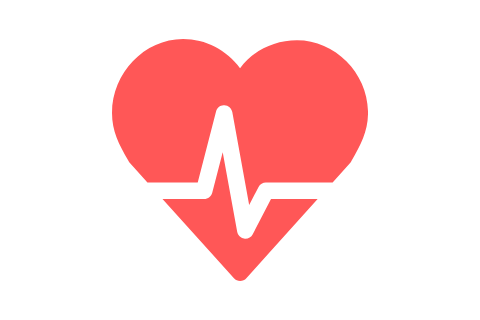
Did you know that one in two Canadians will develop cancer in their lifetime? In 2017, 565 Canadians were diagnosed with cancer every day!
But having cancer is no longer a death sentence. The survival rate of all cancers combined is 63%. That means 63% of people diagnosed with cancer will live five years or longer.
How about heart attacks and stroke? Every year there are 70,000 heart attacks and 50,000 strokes in Canada. That’s one heart attack every seven minutes.
The good news there is that death due to stroke is on the decline since the early 1990s. Since then, the rate of death has declined for both men and women across all age groups.
Like cancer, having a heart attack or stroke doesn’t automatically equate to death. 77% and 72% of Canadians who have a heart attack or stroke survive their respective illnesses.
But 60% of stroke patients are left with some disability. And for more than 40% of stroke patients, the disability is so severe that it requires intense rehabilitation.
You can see that the majority of people who suffer from these illnesses survive them. But what happens to your finances if you suffer a critical illness?
Stroke patients lose almost one-third of their income within three years after suffering the stroke. Likewise, heart attack survivors see their incomes drop by up to 20%. According to research from Great-West Life, London Life and Canada Life,
- Over half of working Canadians (57%) believe the financial impact of suffering a critical illness would be very serious.
- 62% would need to delay retirement, get into debt or downsize their home.
- 54% would be seriously affected financially if their child became critically ill.
One of the causes of the financial impact is drug costs not covered by your provincial health insurance, which are a substantial expense.
As you can see, a critical illness can affect your family life and your ability to work well beyond recovery. A critical illness insurance policy can cover these expenses that arise if an unforeseen illness occurs.
To quote Dr. Marius Barnard, the creator of critical illness insurance:
You need critical illness protection not because you are going to die, but because you are going to survive.
Dr. Marius Barnard Tweet
Now that you know why you need CII, let’s talk about how it works.
2. How Does Critical Illness Insurance Work?
Is cancer covered? What if it is non-life threatening? How much coverage should you get? How do you make a claim?
In this section, you’ll find the answers to all of these questions.
With a critical illness insurance policy, you pay the insurance company a premium. In exchange, you get a tax-free lump sum payment should you suffer from a covered illness.
To make a claim, your illness has to meet the definition as shown in the contract. You also have to survive for 30 days (90 days for some illnesses) before the insurance company will pay out.
Why is there a survival period? Because, if you’ve lived past the survival period, chances are you will be on the road to recovery and you will need the insurance payout. But If you died instead, your life insurance will pay out and you won’t need the CII benefit.
Covered illnesses and their definitions
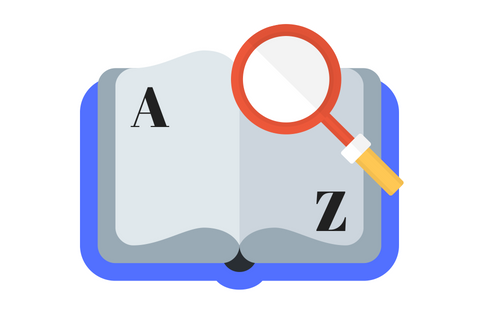
One insurance company’s definition of a critical illness isn’t necessarily the same as another’s. You want to make sure your policy has the best definitions for the covered illnesses.
Why? It can be the difference between your claim being approved or denied. A more restrictive definition results in more claims declined, while a less restrictive one results in more claims approved.
The Canadian Life and Health Insurance Association (CLHIA) benchmark critical illness definitions were developed in 2007 in an effort to standardize the definitions across the industry. It provided a single source for insurance companies to adhere their definitions to.
Benchmark definitions also help consumers by simplifying comparisons between insurance companies.
The typical CII policy covers 25 illnesses and below is a list of them. Click on an illness to expand it and view its definition.
Definition: A definite diagnosis of a progressive degenerative disease of the brain. The insured person must exhibit the loss of intellectual capacity involving impairment of memory and judgment, which results in a significant reduction in mental and social functioning, and requires a minimum of eight hours of daily supervision.
Survival period: 30 days.
Exclusion: No benefit will be payable under this condition for all other dementing organic brain disorders and psychiatric illnesses.
Definition: The undergoing of surgery of the aorta requiring excision and surgical replacement of the diseased aorta with a graft. Aorta refers to the thoracic and abdominal aorta but not its branches.
Survival period: 30 days.
Definition: Chronic persistent bone marrow failure, confirmed by biopsy, which results in anemia, neutropenia, and thrombocytopenia requiring blood product transfusion, and treatment with at least one of the following:
- Marrow stimulating agents;
- Immunosuppressive agents; or
- Bone marrow transplantation.
Survival period: 30 days.
Definition: A definite diagnosis of meningitis, confirmed by cerebrospinal fluid showing growth of pathogenic bacteria in culture, resulting in neurological deficit documented for at least 90 days from the date of diagnosis.
Survival period: 90 days.
Exclusion: No benefit will be payable under this critical illness insured condition for viral meningitis.
Definition: A non-malignant tumour located in the cranial vault and limited to the brain, meninges, cranial nerves or pituitary gland. The tumour must require surgery or radiation treatment or cause irreversible objective neurological deficits.
Survival period: 30 days.
Exclusion: No benefit will be payable for pituitary adenomas less than 10mm. No benefit will be payable for a recurrence or metastasis of an original tumour which was diagnosed prior to the effective date of coverage.
Definition: The definite diagnosis of the total and irreversible loss of vision in both eyes, evidenced by:
- The corrected visual acuity being 20/200 or less in both eyes; or
- The field of vision being less than 20 degrees in both eyes.
Survival period: 30 days.
Definition: Cancer is defined as a definite diagnosis of a tumour characterized by the uncontrolled growth and spread of malignant cells and the invasion of tissue.
Survival period: 30 days.
Exclusion: No benefit will be payable under this condition for the following non-life threatening cancers:
- Carcinoma in situ; or,
- Stage 1A malignant melanoma (melanoma less than or equal to 1.0 mm in thickness, not ulcerated and without Clark level IV or level V invasion); or
- Any non-melanoma skin cancer that has not become metastasized; or
- Stage A (T1a or T1b) prostate cancer.
No benefit will be payable for a recurrence or metastasis of an original cancer which was diagnosed prior to the effective date of coverage.
Another exclusion to be aware of is the 90-day exclusion period for cancer diagnosis after policy issue.
The policy remains in force, but the insured will not have any further coverage for cancer.
Since so many claims are due to cancer, you may decide that it’s not worth keeping the policy if it doesn’t provide any coverage for cancer.
Having the 90-day exclusion clause prevents people from purchasing critical illness insurance while suspecting they may have symptoms of cancer, and cashing in soon after the policy is issued.
Definition: The definite diagnosis of a state of unconsciousness with no reaction to external stimuli or response to internal needs for a continuous period of at least 96 hours, and for which period the Glasgow coma score must be 4 or less.
Survival period: 30 days.
Exclusion: No benefit will be payable for:
- A medically-induced coma;
- A coma which results directly from alcohol or drug use; or
- A diagnosis of brain death.
Definition: The undergoing of heart surgery to correct narrowing or blockage of one or more coronary arteries with bypass graft(s).
Survival period: 30 days.
Exclusion: Any non-surgical or trans-catheter techniques such as balloon angioplasty or laser relief of an obstruction.
Definition: The definite diagnosis of the total and irreversible loss of hearing in both ears, with an auditory threshold of 90 decibels or greater within the speech threshold of 500 to 3,000 Hz.
Survival period: 30 days.
Definition: A definite diagnosis of the death of heart muscle due to obstruction of blood flow, that results in a rise and fall of biochemical cardiac markers to levels considered diagnostic of myocardial infarction, with at least one of the following:
- Heart attack symptoms,
- New electrocardiogram (ECG) changes consistent with a heart attack,
- Development of new Q waves during or immediately following an intra-arterial cardiac procedure including, but not limited to, coronary angiography and coronary angioplasty.
Survival period: 30 days.
Exclusion: Heart attack does not include:
- Elevated biochemical cardiac markers as a result of an intra-arterial cardiac procedure including, but not limited to, coronary angiography and coronary angioplasty, in the absence of new Q waves; or
- ECG changes suggesting a prior myocardial infarction, which do not meet the heart attack definition as described above.
Definition: The undergoing of surgery to replace any heart valve with either a natural or mechanical valve.
Survival period: 30 days.
Exclusion: No benefit will be payable for heart valve repair.
Definition: A definite diagnosis of chronic irreversible failure of both kidneys to function, as a result of which regular hemodialysis, peritoneal dialysis or renal transplantation is initiated.
Survival period: 30 days.
Definition: A definite diagnosis of:
- A total inability to perform, by oneself, at least two of the following six activities of daily living, or
- Cognitive impairment, as defined below,
For a continuous period of at least 90 days with no reasonable chance of recovery.
Activities of daily living are:
- Bathing: The ability to wash oneself in a bathtub, shower or by sponge bath, with or without the aid of equipment;
- Dressing: The ability to put on and remove necessary clothing including braces, artificial limbs or other surgical appliances;
- Toileting: The ability to get on and off the toilet and maintain personal hygiene;
- Bladder and bowel continence: The ability to manage bowel and bladder function with or without protective undergarments or surgical appliances so that a reasonable level of hygiene is maintained;
- Transferring: The ability to move in and out of a bed, chair or wheelchair, with or without the use of equipment; and
- Feeding: The ability to consume food or drink that already has been prepared and made available, with or without the use of adaptive utensils.
Cognitive impairment is defined as mental deterioration and loss of intellectual ability, evidenced by deterioration in memory, orientation, and reasoning, which are measurable and result from a demonstrable organic cause as diagnosed by a specialist. The degree of cognitive impairment must be sufficiently severe as to require a minimum of eight hours of daily supervision. Determination of a cognitive impairment will be made on the basis of clinical data and valid standardized measures of such impairments.
Survival period: 90 days.
Exclusion: No benefit will be payable under this condition for any mental or nervous disorder without a demonstrable organic cause.
Definition: The definite diagnosis of the complete severance of 2 or more limbs at or above the wrist or ankle joint, as the result of an accidental injury or medically-required amputation.
Survival period: 30 days.
Definition: The definite diagnosis of the total and irreversible loss of the ability to speak as the result of accidental injury or disease for a period of at least 180 days.
Survival period: 180 days.
Exclusion: No benefit will be payable under this condition for all psychiatric-related causes.
Definition: A definite diagnosis of the irreversible failure of the heart, both lungs, liver, both kidneys or bone marrow, and transplantation must be medically necessary. To qualify under major organ failure on a waiting list, the insured person must become enrolled as the recipient in a recognized transplant centre in Canada or the United States of America that performs the required form of transplant surgery. For the purposes of the survival period, the date of diagnosis is the date of the insured person’s enrolment in the transplant centre.
Survival period: 30 days.
Definition: A definite diagnosis of the irreversible failure of the heart, both lungs, liver, both kidneys or bone marrow, and transplantation must be medically necessary. To qualify under major organ transplant, the insured person must undergo a transplantation procedure as the recipient of a heart, lung, liver, kidney or bone marrow, and limited to these entities.
Survival period: 30 days.
Definition: The definite diagnosis of one of the following:
- Amyotrophic lateral sclerosis (ALS or Lou Gehrig disease);
- Primary lateral sclerosis;
- Progressive spinal muscular atrophy;
- Progressive bulbar palsy; or
- Pseudobulbar palsy,
And limited to these conditions.
Survival period: 30 days.
Definition: A definite diagnosis of at least one of the following:
- Two or more separate clinical attacks, confirmed by MRI of the nervous system, showing multiple lesions of demyelination; or
- Well-defined neurological abnormalities lasting more than six months, confirmed by MRI of the nervous system, showing multiple lesions of demyelination; or
- A single attack, confirmed by repeated MRI of the nervous system, which shows multiple lesions of demyelination which have developed at intervals at least one month apart.
Survival period: 30 days.
Definition: The definite diagnosis of infection with the human immunodeficiency virus (HIV) resulting from accidental injury during the course of the insured’s normal occupation, which exposed the person to HIV contaminated bodily fluids. The accidental injury leading to the infection must have occurred after the later of the effective date or the date of the last reinstatement of this policy.
Payment under this condition requires satisfaction of all of the following:
- The accidental injury must be reported to the insurer in writing within 14 days of its occurrence;
- A serum HIV test must be taken within 14 days of the accidental injury and the result must be negative;
- A serum HIV test must be taken between 90 and 180 days after the accidental injury and the result must be positive;
- All HIV tests must be performed by a duly licensed laboratory in Canada or the United States of America; and
- The accidental injury must have been reported, investigated and documented in accordance with current Canadian or United States of America workplace guidelines.
Survival period: 30 days.
Exclusion: No benefit will be payable for occupational HIV infection if:
- The insured has elected not to take any available licensed vaccine offering protection against HIV; or
- A licensed cure for HIV infection has become available prior to the accidental injury; or
- HIV infection has occurred as a result of non-accidental injury including, but not limited to, sexual transmission and intravenous (IV) drug use.
Definition: The definite diagnosis of the total loss of muscle function of 2 or more limbs as a result of accidental injury or disease to the nerve supply of those limbs, for a period of at least 90 days following the precipitating event.
Survival period: 90 days.
Definition: A definite diagnosis of primary idiopathic Parkinson’s disease, which is characterized by a minimum of two or more of the following clinical manifestations:
- Muscle rigidity,
- Tremor, or
- Bradykinesia (abnormal slowness of movement, sluggishness of physical and mental responses).
Survival period: 30 days.
Exclusion: No benefit will be payable for all other types of Parkinson’s.
Definition: The definite diagnosis of third-degree burns over at least 20% of the body surface.
Survival period: 30 days.
Definition: A definite diagnosis of an acute cerebrovascular event caused by intra-cranial thrombosis or hemorrhage, or embolism from an extra-cranial source, with:
- Acute onset of new neurological symptoms, and
- New objective neurological deficits on clinical examination persisting for more than 30 days following the date of diagnosis. These new symptoms and deficits must be corroborated by diagnostic imaging testing.
Survival period: 30 days.
Exclusion: No benefit will be payable under this condition for:
- Transient ischaemic attacks; or
- Intracerebral vascular events due to trauma; or
- Lacunar infarcts which do not meet the definition of stroke as described above.
But that’s not all, because most policies also provide a smaller benefit (usually the lesser of 10-25% and $25,000-$50,000) for less severe types of cancer and other ailments.
These include:
- Stage A (T1a or T1b) prostate cancer,
- Ductal carcinoma in situ of the breast, and
- Coronary angioplasty.
The treatments for these conditions are less invasive, have shorter recovery periods and will have less impact on the finances of a covered individual, which is why a full payout is unwarranted.
Any payment down the road for a covered condition will be reduced by the partial benefit. That means if you buy a policy for $100,000 of coverage and make a claim for the smaller benefit of $10,000, you will receive $90,000 if you suffer from one of the 25 major illnesses in the future.
Additional covered conditions for children
If you buy critical illness insurance for your child, he/she will be covered for three to six more conditions, depending on the insurance company.
These are illnesses that have a higher likelihood of affecting children, and they include:
- Autism
- Cerebral palsy
- Congenital heart disease
- Cystic fibrosis
- Muscular dystrophy
- Type 1 diabetes
Coverage for these conditions typically ends when the child turns 25.
How much critical illness insurance should you get?
Now that you know what’s covered, how much CII should you get?
You should plan for the following factors:
1. Loss of income that comes with taking time off work to recover (six months to two years)
2. Loss of income for your spouse for taking time off work to assist in your recovery (three to six months)
3. Medical expenses not covered by provincial health insurance (drug costs and medical equipment, home nursing care, private or out-of-country medical treatment)
4. Manage everyday costs (mortgage, utilities, food, vehicle costs)
5. Extra costs (travel expenses to receive treatment if the health care centre is out of town, childcare costs)
The average cost for a single course of treatment for cancer drugs is $65,000. And this is a report from 2009, so you know this number has only increased in recent years. You should get at least this amount of coverage.
Don’t underestimate the cost to receive treatment out of town. Canadians leaving the country for medical care increased by nearly 40% in 2016.
Part of that is because of the wait times they’re forced to endure to receive treatment in Canada. In 2016, patients had to wait 10.6 weeks to receive treatment deemed medically necessary. That’s almost a month longer than the “clinically reasonable” wait time of seven weeks!
And assuming you take time off work for your recovery, how will you deal with the loss of income? Don’t assume that you will qualify for disability insurance. If you can still do your tasks at work, you won’t qualify for benefits.
This is where critical illness insurance comes in to play. You are not necessarily disabled by definition but you want to take an extended period of time off work for your recovery. Disability insurance won’t pay, so you have to rely on the critical illness insurance lump sum benefit.
If you do qualify for disability insurance, you typically have a 90-day waiting period before benefits start. You can use the critical illness insurance payout to bridge the gap between your last pay cheque and the first payments from disability insurance.
If you don’t have critical illness insurance, you may have to withdraw money from your savings account, RRSP and TFSA. This will drop your retirement fund by as much as 30%!
Because of the wide range of factors listed above, it’s not uncommon to see people buy anywhere between $100,000 to $500,000 of coverage.
Obviously, this amount varies depending on your situation.
There’s also a maximum the insurance company will let you buy. Typically, this amount is limited to a multiple of your income plus your mortgage balance.
For example, up to age 50, RBC Insurance will allow you to buy up to nine times your net income plus the remaining balance on your mortgage. As you get older, the multiple will decrease, resulting in a lower maximum.
How to make a claim for critical illness insurance
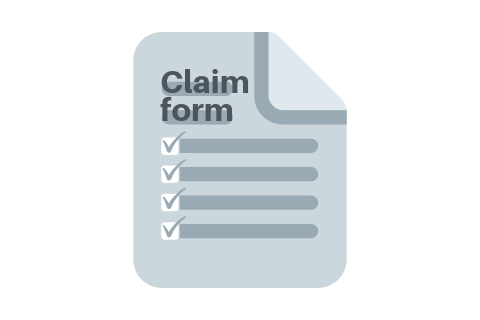
An important part of purchasing any type of insurance is knowing how to make a claim when you are eligible.
For life insurance, the beneficiary will have to submit a claim form, death certificate, and a doctor’s report. While life insurance claims are straightforward, claims for critical illness insurance can be much more complicated.
Remember, you have to provide evidence that the qualifying event has occurred to have your claim approved. For life insurance, the qualifying event is death, which is unambiguous. Claiming for critical illness insurance is trickier.
Why? Because before you get paid, you have to satisfy the insurance company’s definition of the illness as defined in the contract. And if your case is borderline, the insurance company will request more information, which means the claims process is prolonged.
If you’re diagnosed with a critical illness within Canada, you need to provide the following:
- Proof that the policy was in effect when you suffered the critical illness;
- Completion of the survival period (30-90 days after diagnosis);
- A written diagnosis which describes the conditions and cause of the illness; and
- Your complete medical records.
The diagnosis assesses the severity of the illness. It must be prepared and signed by a specialist licensed and practicing in Canada. For critical illnesses diagnosed outside of Canada, the insurance company must make sure you would have received the same diagnosis in Canada.
Also, if medical records are not in English or French, original records are required along with English or French translations.
Before we get to how to make a critical illness claim, let’s take a look at the claims experience for insurance companies:

You can see that cancer makes up the vast majority of the claims, which is why sometimes people refer to it as cancer insurance. Together with heart attack and stroke, they make up more than 80% of all claims!
Now, let’s look at a step-by-step guide for CII claims:
Step 1: Complete claim form
The claim form has two parts: the claimant’s statement and attending physician’s statement.
On the claimant’s statement, you have to provide details about the illness, including the date of diagnosis, the date a medical practitioner was consulted, and symptoms. There are similar questions on the attending physician’s statement. The medical specialist fills it out from his/her perspective.
He/she will also be asked to provide copies of all medical evidence regarding the diagnosis, including test and laboratory results, surgical and consultation records.
For example, with a cancer diagnosis, he/she will have to provide an initial consultation report, pathology report, and oncology report.
You must submit the claim forms within 90 days of suffering the critical illness.
Step 2: Assess
Once the insurance company receives the claim forms, it will assess your eligibility for benefits.
The claims department will inspect your claim carefully to make sure it fits the definition of a critical illness as defined in the contract. It will also confirm that the policy was still in force at the time of diagnosis by ensuring all premiums have been paid to date.
If more information is needed, they will request it directly from the physician.
Step 3: Make claim decision
Some claim decisions can be made within 10 days if all the necessary documents were received by the insurance company when the claim was submitted.
If the claim is accepted, a cheque will be mailed to you. But if it’s denied, the insurance company will send a letter explaining the decision.
If new medical information is available later on, you can re-open your claim to see if you get a better result.
Tips for an efficient claims process
Waiting for the claim decision can be a stressful experience at a time when your sole priority should be achieving a complete recovery.
Here are some tips to speed up the process, increase your chances of approval and lower your level of stress.
1. Completed: Ensure all the information and fields on the claim form is completed, with signatures and dates.
2. Signing: If you are incapacitated and incapable of signing the claim form, ensure it is signed by someone who has power of attorney for property. Submit the power of attorney form appointing the attorney along with the claim form.
3. Exclusions: The main reason that critical illness insurance claims are denied is that you did not read the contract properly. Learn the definition and exclusions of the contract, and manage your expectations in case your claim is repudiated.
4. Communication: Constant communication with your physician, servicing agent, and the insurance company will ensure that everybody understands their role in the claims process.
The bottom line? Going through a critical illness insurance claim can be a challenging and time-consuming process. But as long as you follow these general tips, you shouldn’t have anything to worry about.
3. Critical Illness Insurance Underwriting
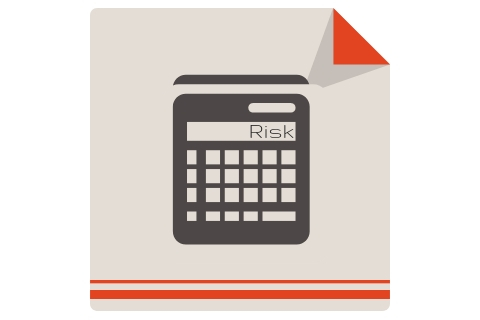
Underwriting is the process that insurance companies use to evaluate the risk of someone applying for insurance coverage.
It means underwriters look at factors that are relevant to the likelihood of the payout of a claim, such as your smoking status, physical build, and medical history.
With the information, they can determine whether to approve an application. It also helps determine the premium to charge that reflects the applicant’s risk.
Although underwriting for critical illness is similar to underwriting for life insurance, some differences are big enough that they merit attention.
Depending on the amount of coverage and your age, you may be required to provide a blood and urine sample, undergo an ECG test and more.
Because payout of a benefit for critical illness insurance happens at the diagnosis of disease, it has a much higher incidence rate than the payout for life insurance, which only takes place at death. Therefore, the level of risk is higher and underwriting is more stringent, making it harder to qualify for critical illness insurance than life insurance.
Here are some of the factors that affect critical illness insurance underwriting.
Your family's medical history
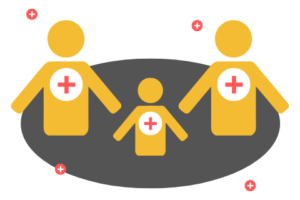
It should come as no surprise that the medical history of your natural parents and siblings is extremely important.
A strong positive family history for hereditary diseases like cancer and diabetes increases the likelihood of such disease manifesting themselves in immediate family members.
The underwriter takes into account the nature of the condition involved and incidence rates among parents and siblings.
The age at diagnosis of a disease for a family member is important as well. The younger one is when diagnosed, the more likely a family member will also develop the illness.
Take the example of a 33-year-old non-smoking male in good health. His father developed colon cancer at age 53. This fact alone would not make a difference in his ability to qualify for life insurance at a standard rating.
But for critical illness insurance, he may be rated 50% (pay 50% more) because he presents a higher risk for cancer.
Major illnesses to be aware of include:
- Cancer
- Diabetes
- Heart disease
- Stroke
- High blood pressure
- Multiple sclerosis
- Huntington’s Chorea
- Alzheimer’s disease
- Kidney disease
- Mental illness
- Any other hereditary disease
Your personal medical history
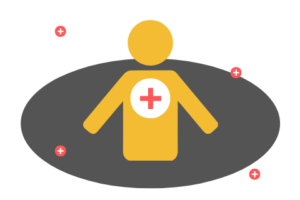
Of course, the underwriter also wants to know your own medical history.
For example, consider a 43-year-old non-smoking male with type 2 diabetes for over 10 years. For life insurance, he may be rated 75%.
But with critical illness insurance, he is likely to be declined because diabetes increases the risk of heart attack, stroke, and loss of limbs.
Any condition that increases the risk of developing a major illness will be met with a rated or declined underwriting decision.
If you had cancer before, you will likely be declined for critical illness insurance even long after successful treatment. The risk of recurrence remains unacceptably high from the insurance company’s perspective. Some exceptions apply, such as non-melanoma skin cancer that has not metastasized.
Your occupation and lifestyle

Lifestyle choices are also important in determining your eligibility for critical illness insurance.
Why? Because, leading a riskier life more prone to suffering a major illness means facing a possible rating or decline.
Alcohol and drug abuse can result in damage to the heart, lungs, kidneys, brain, and liver with serious consequences for a major illness risk.
Excessive drinking and a poor driving record are also connected with accidents leading to an increased risk for covered conditions such as loss of limbs, coma, paralysis, blindness, and burns. The underwriter can request a motor vehicle report to further assess your risk.
Hazardous activities such as hang gliding and motorcycle racing present an increased risk of incurring a claim. This is often handled with a rating or exclusion for the activity.
Most occupations are accepted at standard risk. But individuals with higher risk occupations, such as those that expose them to carcinogens, working at heights or underground or working with explosives will require careful consideration.
An inspection report may be necessary for coverage over $1,000,000. The inspector asks questions about occupation, finances, alcohol/drug consumption, driving record, smoking, medical history, and overall lifestyle.
Pre-screening checklist
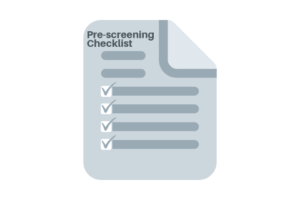
If you’re interested in purchasing critical illness insurance and are wondering if you qualify, you should complete the pre-screening checklist with your agent.
It will ask if you were ever diagnosed with any of the listed illnesses, including cancer, heart disease, kidney disease, insulin-dependent diabetes, and more.
If you have, you are not eligible for critical illness insurance.
If you have any inquiries about a particular situation, ask your broker to submit a preliminary underwriting assessment. It will let you know the likely underwriting decision, saving you time from having to submit an application that you know will be rejected.
Also, if submitting an application that requires more information to evaluate your risk, ask your broker to write a cover letter explaining your condition in full detail.
We know, underwriting is a pain in the neck. But it’s a mandatory part of an insurance application. Try to prepare for it by knowing the type of information required and managing your expectations.
4. How Much Does Critical Illness Insurance Cost? (Sample Quotes)
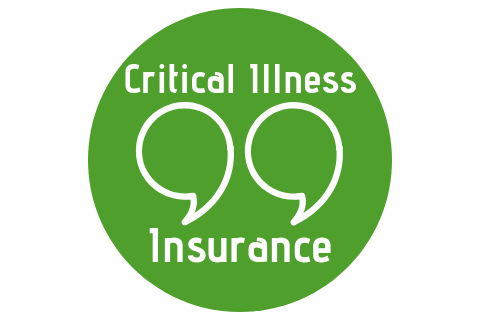
Ok, so you think you’ll pass through underwriting and qualify for critical illness insurance. But now you’re wondering how much it’s going to cost you.
Unlike life insurance quotes, whose presence is ubiquitous online, critical illness insurance quotes are not nearly as easy to get. This section will give you a rough idea of what to expect.
Below are four premium comparison tables, one for each of the following categories: male non-smoker, male smoker, female non-smoker, and female smoker.
The tables show the monthly premiums for $100,000 of coverage for the most common products at different ages. Here is a short description of each product:
The most basic term product, with premiums increasing every ten years until age 75, at which point the policy expires.
Term-10 has the lowest initial cost. You should choose it if you have a short-term need or you’re thinking of retirement in ten years or less.
The premiums shown in the tables below are for the first ten years only.
 Pros: Lowest initial cost.
Pros: Lowest initial cost.
 Cons: Highest long-term cost. Premium jumps every ten years are huge.
Cons: Highest long-term cost. Premium jumps every ten years are huge.
Instead of increasing every 10 years, the premium for term-20 products goes up every 20 years.
Like term-10, term-20 also expires at age 75.
Term-20 costs slightly more than term-10. You should choose it if you have a longer-term need or you’re retiring within 20 years.
Fewer insurance companies carry this product compared to term-10. Both term-10 and term-20 are convertible to term-to-75 or term-to-100 if the insurance company offers them.
The premiums shown in the tables below are for the first 20 years only.
Term-to-75 is a term policy that provides a guaranteed level premium and expires at age 75.
Some companies have an option for a shorter pay period, such as 15 years or until age 65. With a shorter pay period, the premium will be higher. But these options allow you to stop paying the premium during retirement.
Term-to-75 is appropriate if you’re younger and want cost certainty. It lets you carry the policy into retirement when the chance of a critical illness is highest.
The premiums shown in the tables below are for the pay until age 75 option.
 Pros: Lets you carry coverage into retirement at a reasonable cost.
Pros: Lets you carry coverage into retirement at a reasonable cost.
 Cons: Expires at age 75, so you may lose coverage when you need it the most.
Cons: Expires at age 75, so you may lose coverage when you need it the most.
Although it has term in its name, term-to-100 actually provides coverage for life. The premium is level and payable to age 100.
It’s the only ‘whole life’ critical illness insurance product.
Term-to-100 is popular for people who want coverage beyond age 75 and can afford the higher premiums.
Like term-to-75, you can choose a shorter premium payment period with higher premiums.
The premiums shown in the tables below are for the pay until age 100 option.
 Pros: Only product that provides coverage for life. Lowest long-term cost.
Pros: Only product that provides coverage for life. Lowest long-term cost.
 Cons: Highest initial cost.
Cons: Highest initial cost.
Critical illness insurance, $100,000, male non-smoker
| Product | Age 30 | Age 40 | Age 50 | Age 60 |
|---|---|---|---|---|
| Term-10 | $29.07 | $43.92 | $96.93 | $241.20 |
| Term-20 | $33.75 | $62.19 | $141.66 | N/A |
| Term-to-75 | $67.95 | $107.91 | $178.20 | $292.50 |
| Term-to-100 | $83.70 | $124.47 | $218.97 | $422.46 |
Critical illness insurance, $100,000, male smoker
| Product | Age 30 | Age 40 | Age 50 | Age 60 |
|---|---|---|---|---|
| Term-10 | $37.44 | $77.58 | $223.29 | $533.34 |
| Term-20 | $47.43 | $101.70 | $280.53 | N/A |
| Term-to-75 | $105.39 | $182.25 | $354.69 | $662.94 |
| Term-to-100 | $123.66 | $218.61 | $395.91 | $779.67 |
Critical illness insurance, $100,000, female non-smoker
| Product | Age 30 | Age 40 | Age 50 | Age 60 |
|---|---|---|---|---|
| Term-10 | $27.36 | $43.83 | $85.77 | $181.80 |
| Term-20 | $35.10 | $61.29 | $119.34 | N/A |
| Term-to-75 | $61.65 | $92.88 | $141.03 | $214.29 |
| Term-to-100 | $75.60 | $110.70 | $190.17 | $303.75 |
Critical illness insurance, $100,000, female smoker
| Product | Age 30 | Age 40 | Age 50 | Age 60 |
|---|---|---|---|---|
| Term-10 | $30.78 | $74.70 | $167.31 | $349.65 |
| Term-20 | $49.86 | $102.69 | $236.88 | N/A |
| Term-to-75 | $89.55 | $149.49 | $254.70 | $421.65 |
| Term-to-100 | $111.24 | $186.48 | $317.88 | $568.53 |
Like life insurance for smokers, critical illness insurance for smokers is substantially more expensive.
Keep in mind you should compare more than just the premium. You must also compare the number of conditions covered by an insurance company’s product as well as its definitions and exclusions.
Most policies cover about two dozen conditions, but that’s not always the case. Some policies only cover the four major illnesses: cancer, heart attack, stroke, and coronary artery bypass surgery.
The scope of the definition will determine if borderline cases are claimable or not. This is why there is no ‘best critical illness insurance policy’. It’s all about finding the right fit for your current financial situation.
5. Critical Illness Insurance Riders (How You Can Get All Your Premiums Back)
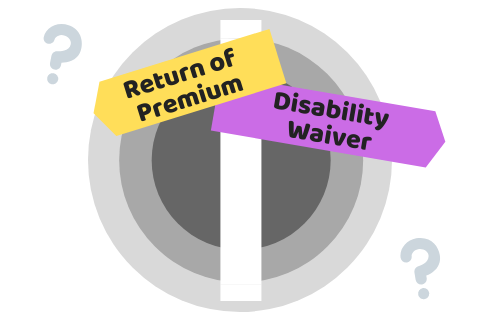
How would you like to get all your money back if you don’t suffer a critical illness? Now you can, if you add one of the following riders.
Riders are optional features that enhance the base coverage. We’ve talked about some common life insurance riders before. Here we look at the benefits of some critical illness insurance riders.
Return of premium (ROP) on death
ROP on death is a low-cost rider. Some insurance companies even build it into their products for no extra cost. If you die with this rider, your beneficiary or estate gets all the premium you paid back. The policy must be in effect when you die. Also, you must not have received a CI benefit.
The premium for this rider is very affordable for younger individuals. For older people, since their mortality rate is greater, it costs more to add the rider to their policies.
The ROP on death rider is a low-cost way for the estate to recover the premiums paid over the life of the policy should death occur before an illness.
Return of premium on expiry (or maturity)
The ROP on expiry rider refunds all your premiums paid when the policy expires, which is age 75 for term-10, term-20 and term-to-75 policies. With a term-10 or term-20 policy, you might not have a chance to exercise this rider.
Why? Because the premium for term policies is astronomical from age 65-75, you may end up letting the policy lapse before you can exercise the rider.
For example, a 30-year-old female non-smoker will pay $27.36/month for $100,000 of coverage in the first 10 years of term-10. But by the time she reaches age 70, she will have to pay $385.38/month to keep the policy in force.
What are the chances of her keeping the policy in force until age 75 for a chance to exercise the ROP on expiry? If you guessed very low, you’re right.
This rider works best for term-to-75 policies. Some insurance companies even let you exercise the refund at age 65.
Return of premium on cancellation (or surrender)
The last return of premium rider, ROP on cancellation, grants you more flexibility than the previous two options. This rider lets you cancel the policy for a refund of premium after a certain number of years. Once cancelled, coverage ceases and you will have to apply for a new policy for continuation of coverage.
What’s the catch?
Well, the premium refunded follows a scale. You’re only refunded a portion if you surrender the policy when the option is first available. It increases to a full refund if you wait longer to exercise the option.
For example, for BMO Insurance’s term-to-100 product, the ROP on cancellation is available starting in year ten of the policy. Only 50% of the premiums paid to date is refundable at that point. However, the percentage of premiums returned increases by 10% every year from years 11-15 until it reaches 100% after 15 years.
ROP on cancellation is the most expensive out of all the ROP options, because of the added flexibility and early access to premiums.
Also, remember that with all ROP options, you either receive the ROP or the critical illness insurance benefit payout, but never both.
If you do suffer a critical illness and have to make a claim, you just paid a higher premium than somebody who didn’t have the rider and got the exact same benefit.
Disability waiver of premium
With this rider, if you suffer a disability and meet a three to six month waiting period, premiums are waived for the duration of the disability.
The rider follows the ‘regular occupation‘ definition of a disability for the first two years. After two years, you have to meet the ‘any occupation‘ definition.
What does this mean? With ‘regular occupation’, you’re considered disabled if you can’t do your own job. But with ‘any occupation’, you’re considered disabled only if you can’t do any job you are qualified for with your education, training, and experience.
So it’s much easier to qualify for disability with the ‘regular occupation’ definition.
If you already have disability insurance, then the monthly benefit should take care of all your expenses, including paying your insurance premiums. This rider is therefore redundant. But if you don’t have a disability insurance policy, you should think about adding this rider.
These are some of the more common riders available on critical illness insurance products. Not all riders are applied the same way by every insurance company. And not every insurance company offers every rider.
This makes it hard to compare CII between different insurance companies. But it makes some of them stand out if you want a certain feature.
Bottom line: Riders are useful for customizing your critical illness insurance policy the way you like it.
Which rider will you consider getting?
6. Should You Buy Critical Illness Insurance? (Is It Worth It?)

One question remains: should you buy critical illness insurance?
To answer that question, you have to ask yourself why you should buy insurance in the first place.
The purpose of all types of insurance, from auto to life to critical illness, is to transfer the potential cost from a loss to an insurance company.
Evaluating the potential loss
The potential financial loss from a car accident or death can be hundreds of thousands of dollars, or even over a million dollars.
This is why auto and life insurance are an integral part of an insurance package.
So does critical illness insurance belong in this package? How do you compare the financial loss of death versus suffering a critical illness?
Death is final and the income loss experienced by surviving family members is permanent. But suffering from a critical illness will not result in a loss to the same degree.
For example, with a less severe case, you may need to spend some time in the hospital, but be back at work after only a couple of months.
Your income stopped for a short period, but with an emergency fund of 3-6 months, it should not affect your financial goals.
But with a more serious illness, you may have to take an extended leave of absence, take expensive drugs for treatment, renovate your home to accommodate your new condition, and require weekly visits from healthcare professionals.
You can bet that you will have to draw on your savings and alter your retirement goals, even if you make a complete recovery.
With such a wide range of outcomes, how do you determine if critical illness insurance is necessary?
You can relate it to car and disability insurance, where the potential loss of a car accident or a disability can range from minor to devastating.
If you believe car and disability insurance is mandatory, then you should also include critical illness insurance too.
Speaking of disability insurance, you might be wondering about the difference between disability and critical illness insurance.
When does disability insurance pay a benefit? How about critical illness insurance?
Take a look at the table below for a comparison between these 2 types of insurance.
| Disability insurance | Critical illness insurance | |
|---|---|---|
| How to qualify | Unable to perform the main duties of your job | Suffer a critical illness as defined in the policy |
| Payout | Monthly benefit for as long as you’re disabled or until you reach the benefit period limit, which can be 2 years, 5 years or age 65 | One-time lump sum benefit |
| Waiting period | Usually 30-120 days | Usually 30 days, depending on the illness |
| Taxable | If personally owned, it is generally tax-free | Tax-free |
| Benefit offset from other sources | Yes, most group LTD insurance and some personal insurance policies have their benefits reduced if you receive payment from other sources such as CPP and Workers’ Compensation | No |
| Exclusions | Includes disabilities caused by normal pregnancies, acts of war, while incarcerated, and more | Includes acts of war, voluntary participation in riots, attempted suicide, committing a criminal offense, and more |
| Premium | Based on occupation | Not based on occupation |
| Availability | Common in employer sponsored benefits | Not common in employer sponsored benefits |
| Who can buy? | Employed or self-employed individuals | Anyone |
There is some overlap, but there are many instances where disability insurance would pay and critical illness wouldn’t, and vice versa.
For example, nerve damage may cause a dentist to be unable to do his job, resulting in disability payout. But if the nerve damage wasn’t caused by one of the covered critical illness, CII won’t pay a benefit.
That’s why it’s important to have both types of insurance.
Factors that will affect your decision
There are other factors you have to consider when thinking about buying critical illness insurance.
Besides the financial impact, the steps to recovery can take an enormous emotional and physical toll on you and your family.
The lump sum benefit from a critical illness insurance payout can afford you and your spouse to take time off work to completely recover emotionally and physically.
Your budget is also another factor that will weigh into your decision.
Having a larger budget lets you purchase a more expensive term-to-75 or term-to-100 policy. But tighter cash flows will limit you to term-10 or term-20 policies.
CII is sometimes an emotional purchase.
How so?
You know people in real life who are survivors of major health events.
Although they made a full recovery, you can see that the episode had a major impact on their finances. Having seen this firsthand will often influence your decision to buy CII.
Even if you do decide to buy critical illness insurance, remember that you have to qualify for it through underwriting.
Underwriting is different from life insurance, and the decline rate is higher for critical illness insurance.
The next step you should take is to complete a preliminary underwriting assessment.
It will let you know the probable underwriting decision, without going through the entire application and undergoing blood tests or medical exams.
Now, let’s take a look at a case study where critical illness insurance played a huge part in a couple’s financial plan…
7. Case Study (How Critical Illness Insurance Protected This Couple's Retirement)

How will having a major health event affect your retirement plans?
Consider the following example. John and Jane are married. John is 45 years old and Jane is 42 years old. Together they have $100,000 saved up for retirement.
They are currently contributing $15,000 annually into their RRSP in a moderate growth portfolio, with a 6% expected return.
They both make $70,000 annually, have long-term disability coverage through their employers, and are in the 30% marginal tax bracket.
In scenario A, they both remain healthy and retire happily with $905,604 at age 65. If they wait until mandatory conversion to an RRIF before withdrawal at age 71, they will have a nest egg of almost $1.4 million (blue line below).
Without critical illness insurance
In scenario B, John is diagnosed with cancer at age 55 and survives. Although treatment and drugs administered in the hospital are covered by the provincial health plan, coverage ceases after he is discharged from the hospital.
The average drug cost for a single course of treatment of cancer with drugs is $65,000. Assuming Jane takes six months off work to provide in-home care for John resulting in an income loss of $35,000, the total cost due to the illness is $100,000.
John may qualify for disability benefits through EI and his group coverage. But EI only replaces a small percentage of his income and his group benefits likely won’t kick in until 4 months after disability.
John and Jane will have to withdraw $140,000 from their RRSPs to net $100,000 after-tax since they are in the 30% tax bracket.
The withdrawal drops their retirement funds to $626,411 at age 65 and slightly under $1 million at age 71 (red line below), a far cry from their total had John been healthy.
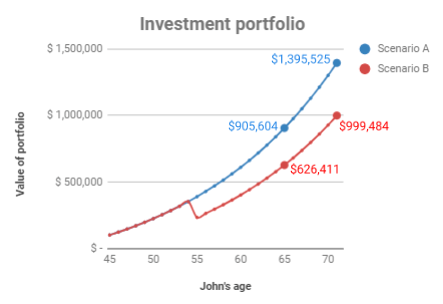
Withdrawing money from the RRSP, especially such a large amount, results in a significant immediate tax liability and diminishes the tax deferral benefit of the RRSP.
Their retirement fund will be stretched thin, and it will take five years for their investment portfolio to catch up to scenario A.
This results in John and Jane having to work longer and retire later or reducing their quality of life in retirement to get back on track, none of which are preferable.
Let’s take a look at how they can avoid this with critical illness insurance, and how much of a difference it will make.
With critical illness insurance
In scenario C, John purchases $100,000 of critical illness insurance at age 45 for $2,193/year. This drops his RRSP contributions from $15,000/year to $12,807/year.
The plan he chooses provides term coverage to age 75, with the option to have all premiums refunded at age 65 if he does not suffer a critical illness.
If he is diagnosed with cancer at age 55, he receives $100,000 in insurance proceeds tax-free, covering the cost of the drug treatment and Jane’s loss of income. They will not have to dip into their RRSP, and their retirement plan will remain unaffected.
If John does not suffer any of the covered critical illnesses by age 65, all the premium he paid into the policy will be returned to him tax-free.
That means the insurance company will write him a cheque for $43,860 ($2,193/year x 20 years).
Not bad for not suffering a critical illness.
He can contribute this amount to their RRSPs to boost their retirement funds. Notice the bump in their RRSP portfolio that takes their balance to $866,585 at age 65 and $1.32 million at age 71 (green line below).

The return of premium or insurance benefit, whichever John receives, can be used for any purpose he sees fit.
If it turns out he overestimated the drug costs for the treatment of cancer, he can use the contribute the excess into his RRSP. He can also use it to pay for in-home nursing care so Jane can remain at work.
The return of premium can be used to pay off any remaining balance on the mortgage, so they can retire debt free. They have complete freedom as to how they would like to allocate their money.
John can also continue the critical illness insurance policy past age 65 by declining the return of premium option if he feels like he requires the coverage until age 75. The probability of suffering a critical illness increases as we age, so he may prefer to keep the policy just in case.
Although the example only showed coverage for John, Jane is equally as important to the family and is also a suitable candidate for critical illness insurance.
Without critical illness insurance, John and Jane’s retirement plans may be in jeopardy if a serious illness strikes either of them.
With the protection in place, they create a safety net to protect their retirement savings so their long-term financial plans aren’t interrupted by a serious illness.
This is how critical illness insurance saved this couple’s retirement plan.
Did This Critical Illness Insurance Guide Answer Your Questions?
Phew, you’ve finished reading the definitive critical illness insurance guide. Are you ready to take the next step to protect your financial plan in case of a major illness?
Do you think term-10 or term-75 is a better fit?
Do you have any medical history that may pose a problem during underwriting?
Or do you want to complete a preliminary underwriting assessment to determine your eligibility?
We would be happy to have a free consultation with you to find you the right coverage. Please contact us at info@briansoinsurance.com or 604-928-1628.
Get Your Critical Illness Insurance Quote Now
While we make every effort to keep our site updated, please be aware that timely information on this page, such as quote estimates, or pertinent details about companies, may only be accurate as of its last edit day. Brian So Insurance and its representatives do not give legal or tax advice. Please consult your own legal or tax adviser. This post is a brief summary for indicative purposes only. It does not include all terms, conditions, limitations, exclusions, and other provisions of the policies described, some of which may be material to the policy selection. Please refer to the actual policy documents for complete details which can be provided upon request. In case of any discrepancy, the language in the actual policy documents will prevail. A.M. Best financial strength ratings displayed are not a warranty of a company’s financial strength and ability to meet its obligations to policyholders.





1 Comment
[…] A fan and contributor to this site, Brian So, shared this definitive guide to critical illness insur… Smart stuff worth a read to be well informed. […]